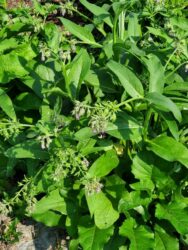By volunteer
By Tony Jevans and Cliff Keller

Comfrey, genus Symphytum, is a perennial herbaceous shrub originating from Eurasia with more than 35 species. It is not grown for food in the Edible Garden, but for its unique use as a dynamic accumulator as well as a pollinator attractor.
The species: Symphytum officinale known as common comfrey, and the Russian comfrey, Symphytum uplandicum, are grown in the Edible Garden. They have deep roots which allow comfrey to access the nutrients from deep in the subsoil that normally remain inaccessible to other plants. These nutrients are relocated throughout the plant giving the leaf biomass a great balance of major plant nutrients (nitrogen, phosphorous, potassium).

Comfrey prefers moist, fertile soils but adapts to many soils with a pH of 6.5 to 8.5. However, the best yield occurs in soils with a pH of 6.0 to 7.0. It grows well in full sun to part shade. The herb can be grown from seed and cuttings, but grows best from bare-root crowns started in a pot rather than directly in the garden. Comfrey is cold hardy, dying back in winter and returning again in spring. It needs to be divided every few years to keep the plant healthy with plenty of space for the root system.
The plants should be allowed to establish well-developed roots the first year. The following year, allow the plants to flower at least once during the season to provide the high nectar fodder popular with honey bees and other pollinators. When comfrey plants get about two feet tall they can be harvested by cutting the plant to 2 inches from the ground. Frequently, the plants can grow to a height of 3 to 5 feet.
Freshly-cut comfrey leaves make good mulch as they have a high nitrogen content (17%). Their high potassium content makes them beneficial for tomatoes, potatoes, peppers and cucumbers as well as berries and fruit trees. Liquid fertilizer can be made by shredding the leaves and steeping them in water for 3 to 6 weeks in a covered barrel. The resulting stinky “Comfrey Tea” can be used full strength or diluted with water.

Comfrey has been used medicinally for thousands of years because of its healing properties for skin and bone problems. Containing allantoin, its topical application can relieve distress from skin irritations, cuts, sprains, swelling and for insect bites. Historically, the Greeks and Romans used comfrey to treat bronchial problems and stop heavy bleeding. Although the leaves have been used for internal ailments, in salads, and as potherb, recent studies have linked comfrey to liver toxicity and cancer in rats. In 2001, the FDA banned edible products containing comfrey.
Farmers have taken advantage of comfrey’s high protein content as its wilted leaves are enjoyed by horses, cows, goats, and chickens.

